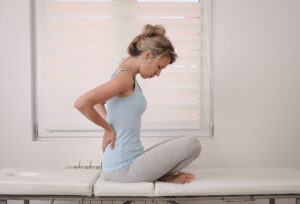Pelvic Pain falls under the umbrella of Pelvic floor Dysfunction and affects millions of women worldwide. Where the list of symptoms seems to be ever-growing and the causes are not always understood, finding relief can be an overwhelmingly frustrating experience.
As such, self-care practices should be at the forefront of our recovery.
Why? Because they can go a long way to not only easing symptoms but can be amazingly effective at addressing the underlying causes of our suffering. Yoga is one of those practices.
Many dismiss the idea that yoga can help them with their pelvic pain, so my intention in writing this is to explain how and why different components within yoga help not only pelvic pain but any medical condition or life situation we may be experiencing.
Yoga & Yoga Therapy
In the mainstream, yoga is depicted as a group yoga class with the students young and slender and twisted up into impressive poses. And where this variation of yoga certainly exists (20 some odd years ago, I used to be one of those younger, slim, bendy students 😉 ), the various styles and approaches to yoga out there cater to new students, curvy students, older students, or even injured/ill students, as in the case of Yoga Therapy.
Yoga Therapy is an approach that focuses entirely on the healing journey of the one student in front of the yoga therapist, and the classes are designed specifically for their needs.
The practices of yoga can help with what ails you, no matter what it is, and this is why: yoga is more than fancy poses. Yes, yes, yoga can be a challenging physical workout. I’ve taken classes where I had sweat dripping off the end of my nose and my elbows. But that’s not what I’m talking about here. The traditional practices and techniques of yoga include much more than poses. And often, they are what we need to overcome anxiety and pain and to heal.

The self-care practices for pelvic pain used within a yoga therapy session* include (but are not limited to):
Breathing. Breathing practices have many benefits, some of which include down-regulation of the nervous system, releasing held muscles, and reconnecting with and healing the pelvic floor. Focus on our breath provides internal focus to cultivate self/body awareness (see below), and acts as a focus to use within meditation practice.
Movement. It doesn’t have to be fancy or challenging, but movement is key to feeling better. It provides gentle stretching for our muscles and range of motion for our joints, as well as giving us another internal focus. Additionally, it releases muscular and mental tension along with feel-good chemicals in the brain.
Poses. I list this separately because movement informs the nervous system of what is safe, and I use a lot of movement in my sessions before holding poses. Held poses then develop strength, allow for a deeper stretch, and create resilience. All of which are needed for a happy body and a calm mind.
Self-awareness/Body-awareness. As we develop an awareness of the body (via paying attention to our breathing, our positioning, and the sensations created in our movement), we begin to develop awareness of our thoughts, self-talk, decisions, and habits that might be contributing to our discomfort such as clenching our jaws or watching shows that add to our stress. Our thoughts and self-talk can throw us deeper down the rabbit hole of despair or be used to uplift us. Noticing when we get caught up in recurring negative thinking and redirecting thoughts to more positive things is an important part of healing.
Deep relaxation. This can come in the form of meditation, body scans, guided imagery, and yoga Nidra (yoga Nidra includes all of the above, in a long guided script that is often specifically written for the student.) Relaxing once a year on vacay is not enough. We must practice daily to offset our daily stressors.
* Some group yoga classes -especially those with a therapeutic focus – may include some or all of the techniques above.
The Conclusion
The self-care practices within a yoga practice are extremely effective at down-regulating the nervous system (releasing tension, easing anxiety) and addressing chronic pain, including pelvic pain. If you are experiencing anxiety and/or pain and any/all of the other emotions and challenges that tag along, seek out a gentle-if-not-therapeutic class or, better yet, a yoga therapist to design your perfect practice.
I work in-person and virtually, and I am sharing a link below to help you find other certified yoga therapists near you:
Thanks for reading.

